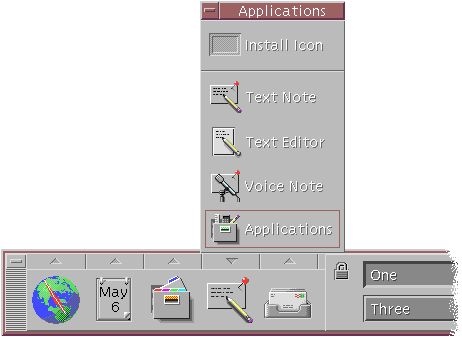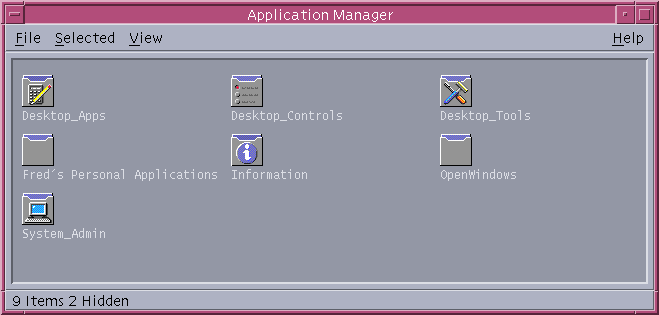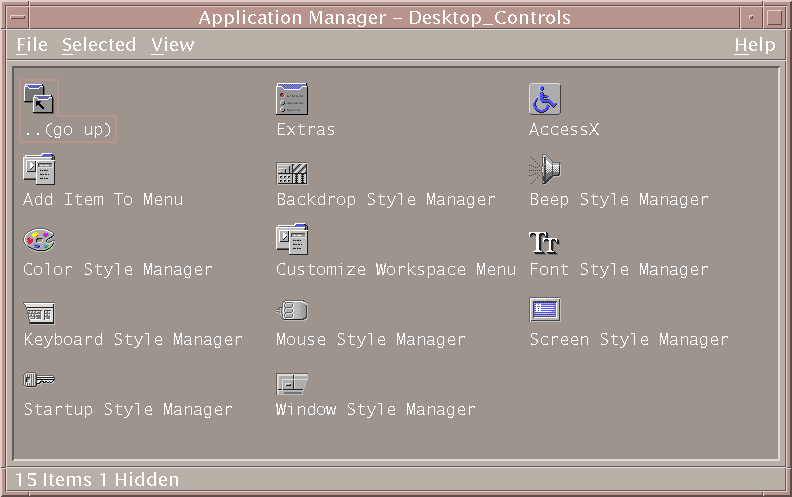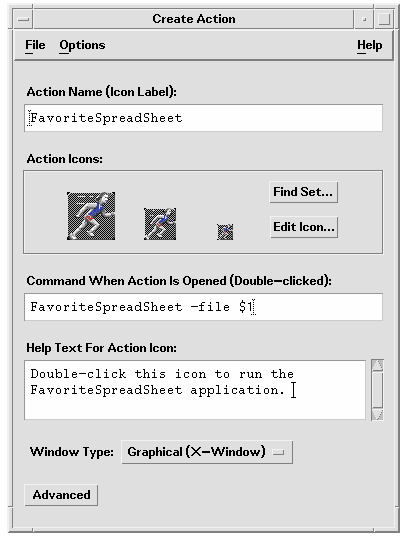Chapter 8 Using Application Manager
Application Manager is a container for the applications and other tools available on your system. (The relationship between Application Manager and the Front Panel and Workspace menu is explained in Running Applications.)
This chapter explains how to use and make personal customizations to Application Manager. Customizations are typically carried out by the system administrator.
To Open Application Manager
-
Open the Application subpanel by clicking the tab above the Text Note control on the Front Panel.
Figure 8–1 Application Manager control

-
Click Applications.
The main Application Manager window is displayed
Figure 8–2 Personal Applications Group in Applications Manager

Application Manager Windows
The Application Manager window is a special File Manager view of the Application Manager in your file system. It looks and behaves somewhat like a File Manager window, but it is populated each time you log in, and you cannot copy new applications and files directly into it.
The main window contains a set of application groups, or folders containing icons that you use to start applications; some application groups contain other useful application files such as sample data files, templates, and ``read me'' files. The application groups may be located on your system or on other systems throughout the network. An icon that starts an application is called an action icon or application icon.
Figure 8–3 Action (Application) Icons in the Desktop_Apps Application Group

The application groups in your Application Manager are either built in or registered by your system administrator. CDE provides the built-in application groups listed in the following table.
Table 8–1 Application Groups in Application Manager| Application Group | Description |
|---|---|
| Desktop_Apps | Applications and accessories typically found in a desktop environment, (for example: Calculator, File Manager and Text Editor). |
| Desktop_Controls | Applications typically used for setup and customization of the desktop (for example, Customize Workspace Manager and Restore Front Panel). |
| Desktop_Tools | File manipulation tools that are typically used by people who understand actions and file types |
| Information | Online documentation and release notes. |
| System_Admin | Tools for use by the system administrator and for people working with hardware devices such as CD-ROM drives and disks. |
Menus and Commands
Since Application Manager is closely related to the File Manager window, it uses most of the same menus, commands, and other features.
For more information about using the File Manager menus and dialog boxes, see Chapter 5, Managing Files with File Manager .
To Run an Application
-
Open Application Manager.
-
Double-click the application group's icon to display its contents.
-
Double-click the application's action icon.
Figure 8–4 Opening an Application Window from Application Manager

Setting up Applications
You can put an application on the Front Panel or on your desktop. You can also create your own application group in Application Manager.
To Put an Application Icon in the Front Panel
-
Display the application's icon in Application Manager.
-
Display the subpanel to which you want to add the application.
-
Drag the action icon from Application Manager to the Install Icon control in the subpanel.
Figure 8–5 Installing an Application (Action Icon) in the Front Panel

To Put an Application Icon on the Workspace Backdrop
This procedure copies an application icon from Application Manager to the workspace (backdrop). This makes the icon available when you don't have an Application Manager window open
-
Open the application group containing the application you want to add.
-
Drag the application from Application Manager to the workspace backdrop.
To Create a Personal Application Group
A personal application group is an application group that you can alter, since you have write permission to it.
-
From your home folder, change to the .dt/appmanager subfolder.
-
Create a new folder and name it.
The folder name will become the name of the new application group.
-
Double-click Reload Applications in the Desktop_Controls application group.
Your new application group will become registered at the top level of Application Manager.
To Add Applications to a Personal Application Group
-
Copy icons from other application groups to the personal application group.
For example, you can copy (by dragging) the Calculator icon from the Desktop_Tools application group to your new personal application group.
-
Create an action for an application and then place an application (action) icon in the personal application group.
To Update Application Manager
The contents of your Application Manager are built each time you log in. Each time it is built, it searches certain system and network locations for applications.
If your system administrator adds an application to your system or to an application server while you are in a session, you must update your Application Manager if you want the new application to be registered immediately.
There are two ways to update Application Manager:
-
Open the Desktop_Controls application group and double-click Reload Applications.
-
Or, log out and log back in.
Advanced Application Manager Concepts
This section describes several advanced Application Manager concepts:
-
The relationship between file names and icon labels
-
The folder location of Application Manager
-
Creating personal actions and data types
-
Where to obtain additional information about customizing Application Manager
File Names in Application Manager
Unlike regular files displayed in File Manager, the name displayed below an application icon in Application Manager is the action icon's label, not the action file name. Normally, you do not need to know the action file name.
However, there are situations where you may see the file name, for example, if you use the Copy File dialog box to copy the icon. In such cases, select the file and choose Copy To from the Selected menu, and the Copy To dialog box will display the file name.
Folder Location of Application Manager
Application Manager behaves much like File Manager. This is because Application Manager is a File Manager view of a special folder on your system used to gather registered applications. Ordinarily, you do not need to know the location of this special folder. However, its location may be useful to you if you are trying to troubleshoot problems.
Login Manager creates the Application Manager folder each time you log in. Its location is:
/var/dt/appconfig/appmanager/special_folder_name
where special_folder_name is a name assigned by the system that is unique for your system and login name.
You should never attempt to directly modify the special_folder_name folder from a command line.
Creating Personal Actions and Data Types
The desktop provides a tool that helps you create icons for running scripts, applications, and other commands. You may want to use this tool if you have a personal application your system administrator has not configured for you.
For example, suppose you have your own favorite spreadsheet application that you usually start by typing a command into a terminal emulator window:
FavoriteSpreadSheet -file data_file
You can create an icon that runs this command so that you won't have to continue manually typing it. To do this, you must create a special desktop ``macro'' called an action. You can also create a data type for each data_file.
The desktop includes a tool called Create Action that makes it easy to create actions and data types. To open the Create Action window, double-click the Create Action icon in the Desktop_Apps application group.
Figure 8–6 Create Action Window

To Get Help on the Create Action Window
-
Choose Tasks from the Create Action window's Help menu.
-
Click the hyperlink ``To Create an Action With Create Action.''
Create Action:
-
Creates an action for your application
-
Places an action icon in your home folder.
You can move or copy that icon to other locations—for example, to a personal application group that you've created.
-
Registering Applications
When an application is registered in Application Manager, it has its own application group. This application group is available to all users on the system.
Registering applications is an advanced task, since it requires you to be the root user. For instructions, see the Advanced User's and System Administrator's Guide.
- © 2010, Oracle Corporation and/or its affiliates
